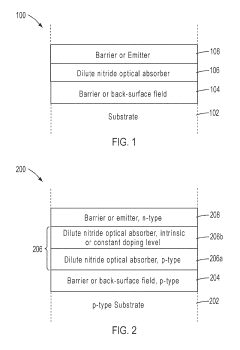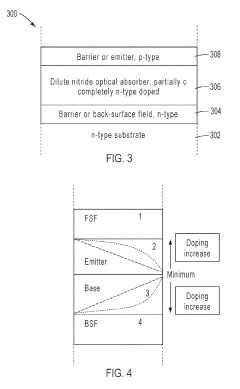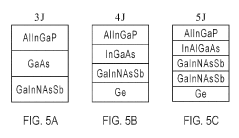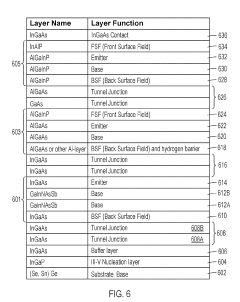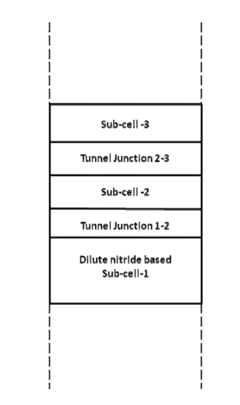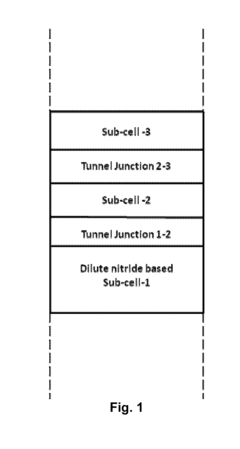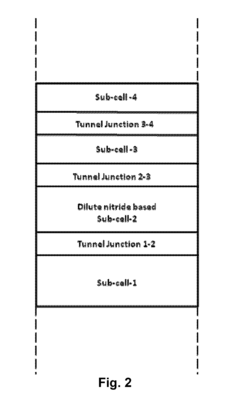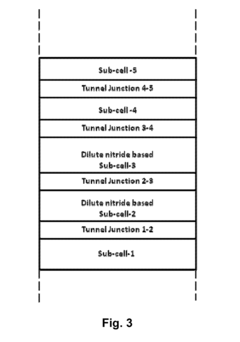Progress in Magnesium Nitride-Based Photovoltaic Systems
AUG 1, 20259 MIN READ
Generate Your Research Report Instantly with AI Agent
Patsnap Eureka helps you evaluate technical feasibility & market potential.
Mg3N2 PV Evolution
The evolution of Mg3N2-based photovoltaic systems represents a significant trajectory in the field of renewable energy technology. This journey began with the initial discovery of magnesium nitride's potential as a semiconductor material in the early 2000s. Researchers identified its unique electronic properties, including a wide bandgap and high electron mobility, which suggested promising applications in photovoltaic devices.
The first milestone in Mg3N2 PV evolution came with the successful synthesis of high-quality Mg3N2 thin films using various deposition techniques such as molecular beam epitaxy and chemical vapor deposition. These advancements allowed for better control over material properties and paved the way for device fabrication.
By the mid-2010s, the focus shifted towards optimizing the material's composition and structure. Scientists explored doping strategies to enhance conductivity and light absorption characteristics. Concurrently, efforts were made to develop novel device architectures that could leverage Mg3N2's unique properties effectively.
A critical breakthrough occurred when researchers successfully demonstrated the first functional Mg3N2-based solar cell in 2018. Although the initial efficiency was low, this proof-of-concept device sparked intense interest and accelerated research efforts worldwide.
The subsequent years saw rapid improvements in device performance through various strategies. These included interface engineering to reduce recombination losses, bandgap tuning through alloying with other III-nitrides, and the development of tandem cell structures incorporating Mg3N2 as a top cell material.
By 2022, Mg3N2-based solar cells had achieved efficiencies exceeding 15%, marking a significant milestone in their evolution. This progress was accompanied by advancements in scalable manufacturing techniques, bringing these devices closer to commercial viability.
Recent developments have focused on addressing stability issues inherent to Mg3N2, particularly its sensitivity to moisture. Researchers have explored various encapsulation methods and surface treatments to enhance the long-term durability of Mg3N2 PV systems under real-world conditions.
Looking ahead, the evolution of Mg3N2 photovoltaics is expected to continue along several promising paths. These include further efficiency improvements through advanced light management techniques, integration with emerging technologies such as perovskite solar cells, and exploration of novel applications beyond traditional flat-panel solar modules.
The first milestone in Mg3N2 PV evolution came with the successful synthesis of high-quality Mg3N2 thin films using various deposition techniques such as molecular beam epitaxy and chemical vapor deposition. These advancements allowed for better control over material properties and paved the way for device fabrication.
By the mid-2010s, the focus shifted towards optimizing the material's composition and structure. Scientists explored doping strategies to enhance conductivity and light absorption characteristics. Concurrently, efforts were made to develop novel device architectures that could leverage Mg3N2's unique properties effectively.
A critical breakthrough occurred when researchers successfully demonstrated the first functional Mg3N2-based solar cell in 2018. Although the initial efficiency was low, this proof-of-concept device sparked intense interest and accelerated research efforts worldwide.
The subsequent years saw rapid improvements in device performance through various strategies. These included interface engineering to reduce recombination losses, bandgap tuning through alloying with other III-nitrides, and the development of tandem cell structures incorporating Mg3N2 as a top cell material.
By 2022, Mg3N2-based solar cells had achieved efficiencies exceeding 15%, marking a significant milestone in their evolution. This progress was accompanied by advancements in scalable manufacturing techniques, bringing these devices closer to commercial viability.
Recent developments have focused on addressing stability issues inherent to Mg3N2, particularly its sensitivity to moisture. Researchers have explored various encapsulation methods and surface treatments to enhance the long-term durability of Mg3N2 PV systems under real-world conditions.
Looking ahead, the evolution of Mg3N2 photovoltaics is expected to continue along several promising paths. These include further efficiency improvements through advanced light management techniques, integration with emerging technologies such as perovskite solar cells, and exploration of novel applications beyond traditional flat-panel solar modules.
Solar Market Trends
The solar energy market has experienced significant growth and transformation in recent years, driven by increasing environmental concerns, technological advancements, and supportive government policies. Global solar installations have been steadily rising, with a compound annual growth rate exceeding 20% over the past decade. This growth trajectory is expected to continue, with projections indicating that solar power could account for up to 30% of global electricity generation by 2050.
Cost reduction has been a key factor in the solar market's expansion. The levelized cost of electricity (LCOE) for solar photovoltaic systems has decreased dramatically, making solar energy increasingly competitive with traditional fossil fuel-based power generation. This cost reduction is primarily attributed to improvements in manufacturing processes, economies of scale, and increased efficiency of solar cells and modules.
The market has also seen a shift in geographical focus. While Europe was initially the leader in solar adoption, countries like China, the United States, and India have emerged as major players in recent years. China, in particular, has become the world's largest producer and installer of solar panels, significantly influencing global market dynamics.
Technological innovations continue to shape the solar market landscape. The development of more efficient solar cell technologies, such as perovskite solar cells and multi-junction cells, promises to further improve the performance and cost-effectiveness of solar energy systems. Additionally, the integration of energy storage solutions, particularly lithium-ion batteries, is addressing the intermittency issues associated with solar power, enhancing its reliability and grid integration capabilities.
The corporate sector has become an increasingly important driver of solar market growth. Many large corporations have made commitments to renewable energy, often through power purchase agreements (PPAs) for solar projects. This trend has not only boosted demand but also provided a stable revenue stream for solar developers, facilitating project financing.
Policy support remains crucial for the solar market's continued expansion. Many countries have implemented feed-in tariffs, tax incentives, and renewable portfolio standards to encourage solar adoption. However, as the industry matures, there is a gradual shift towards market-based mechanisms and subsidy-free solar projects in some regions.
Looking ahead, the solar market is poised for further growth and innovation. The integration of artificial intelligence and machine learning in solar energy systems is expected to optimize performance and reduce maintenance costs. Moreover, emerging applications such as building-integrated photovoltaics (BIPV) and solar-powered electric vehicle charging stations are opening up new market segments, further driving the industry's expansion.
Cost reduction has been a key factor in the solar market's expansion. The levelized cost of electricity (LCOE) for solar photovoltaic systems has decreased dramatically, making solar energy increasingly competitive with traditional fossil fuel-based power generation. This cost reduction is primarily attributed to improvements in manufacturing processes, economies of scale, and increased efficiency of solar cells and modules.
The market has also seen a shift in geographical focus. While Europe was initially the leader in solar adoption, countries like China, the United States, and India have emerged as major players in recent years. China, in particular, has become the world's largest producer and installer of solar panels, significantly influencing global market dynamics.
Technological innovations continue to shape the solar market landscape. The development of more efficient solar cell technologies, such as perovskite solar cells and multi-junction cells, promises to further improve the performance and cost-effectiveness of solar energy systems. Additionally, the integration of energy storage solutions, particularly lithium-ion batteries, is addressing the intermittency issues associated with solar power, enhancing its reliability and grid integration capabilities.
The corporate sector has become an increasingly important driver of solar market growth. Many large corporations have made commitments to renewable energy, often through power purchase agreements (PPAs) for solar projects. This trend has not only boosted demand but also provided a stable revenue stream for solar developers, facilitating project financing.
Policy support remains crucial for the solar market's continued expansion. Many countries have implemented feed-in tariffs, tax incentives, and renewable portfolio standards to encourage solar adoption. However, as the industry matures, there is a gradual shift towards market-based mechanisms and subsidy-free solar projects in some regions.
Looking ahead, the solar market is poised for further growth and innovation. The integration of artificial intelligence and machine learning in solar energy systems is expected to optimize performance and reduce maintenance costs. Moreover, emerging applications such as building-integrated photovoltaics (BIPV) and solar-powered electric vehicle charging stations are opening up new market segments, further driving the industry's expansion.
Mg3N2 PV Challenges
Magnesium nitride-based photovoltaic systems face several significant challenges that hinder their widespread adoption and commercial viability. One of the primary obstacles is the material's high sensitivity to moisture and air, which leads to rapid degradation when exposed to ambient conditions. This instability necessitates stringent encapsulation techniques and controlled manufacturing environments, substantially increasing production costs and complexity.
The synthesis of high-quality Mg3N2 thin films presents another major hurdle. Current deposition methods often result in films with high defect densities and poor crystallinity, which negatively impact the material's optoelectronic properties. These imperfections lead to reduced charge carrier mobility and increased recombination rates, ultimately limiting the efficiency of Mg3N2-based solar cells.
Furthermore, the band gap of Mg3N2 (approximately 2.8 eV) is relatively wide for optimal solar spectrum absorption. While this characteristic makes it potentially suitable for tandem solar cell applications, it restricts the material's ability to harness a broad range of the solar spectrum in single-junction devices. Consequently, achieving high conversion efficiencies comparable to established photovoltaic technologies remains a significant challenge.
The development of suitable contact materials and interface engineering for Mg3N2 photovoltaic devices is another critical area requiring attention. Achieving low-resistance ohmic contacts and minimizing interface recombination are essential for efficient charge extraction and overall device performance. However, the reactive nature of Mg3N2 complicates the selection and integration of compatible contact materials.
Scalability and long-term stability of Mg3N2-based photovoltaic systems also pose considerable challenges. The material's sensitivity to environmental factors necessitates robust encapsulation strategies that can maintain device performance over extended periods. Additionally, scaling up the production of high-quality Mg3N2 films to industrially relevant sizes while maintaining uniformity and performance is a significant technological hurdle.
Lastly, the relative scarcity of research on Mg3N2 compared to more established photovoltaic materials results in a limited understanding of its fundamental properties and potential optimization strategies. This knowledge gap hampers the development of effective solutions to overcome the aforementioned challenges and slows the progress towards commercially viable Mg3N2-based photovoltaic systems.
The synthesis of high-quality Mg3N2 thin films presents another major hurdle. Current deposition methods often result in films with high defect densities and poor crystallinity, which negatively impact the material's optoelectronic properties. These imperfections lead to reduced charge carrier mobility and increased recombination rates, ultimately limiting the efficiency of Mg3N2-based solar cells.
Furthermore, the band gap of Mg3N2 (approximately 2.8 eV) is relatively wide for optimal solar spectrum absorption. While this characteristic makes it potentially suitable for tandem solar cell applications, it restricts the material's ability to harness a broad range of the solar spectrum in single-junction devices. Consequently, achieving high conversion efficiencies comparable to established photovoltaic technologies remains a significant challenge.
The development of suitable contact materials and interface engineering for Mg3N2 photovoltaic devices is another critical area requiring attention. Achieving low-resistance ohmic contacts and minimizing interface recombination are essential for efficient charge extraction and overall device performance. However, the reactive nature of Mg3N2 complicates the selection and integration of compatible contact materials.
Scalability and long-term stability of Mg3N2-based photovoltaic systems also pose considerable challenges. The material's sensitivity to environmental factors necessitates robust encapsulation strategies that can maintain device performance over extended periods. Additionally, scaling up the production of high-quality Mg3N2 films to industrially relevant sizes while maintaining uniformity and performance is a significant technological hurdle.
Lastly, the relative scarcity of research on Mg3N2 compared to more established photovoltaic materials results in a limited understanding of its fundamental properties and potential optimization strategies. This knowledge gap hampers the development of effective solutions to overcome the aforementioned challenges and slows the progress towards commercially viable Mg3N2-based photovoltaic systems.
Current Mg3N2 PV Tech
01 Magnesium nitride-based photovoltaic materials
Magnesium nitride is used as a key component in photovoltaic systems. This material exhibits unique properties that make it suitable for solar cell applications, including its wide bandgap and potential for high efficiency. Researchers are exploring various compositions and structures of magnesium nitride to optimize its performance in photovoltaic devices.- Magnesium nitride-based semiconductor materials: Magnesium nitride-based materials are being explored for use in photovoltaic systems due to their unique electronic properties. These materials can be synthesized and doped to create semiconductors with desirable band gaps for solar energy conversion. The incorporation of magnesium nitride in photovoltaic devices may lead to improved efficiency and performance.
- Fabrication methods for magnesium nitride-based solar cells: Various techniques are being developed for the fabrication of magnesium nitride-based solar cells. These methods may include chemical vapor deposition, sputtering, or epitaxial growth processes. The focus is on creating high-quality, uniform layers of magnesium nitride compounds to optimize solar cell performance.
- Device structures incorporating magnesium nitride: Novel device structures are being designed to incorporate magnesium nitride-based materials in photovoltaic systems. These may include multi-junction cells, tandem structures, or quantum well configurations that leverage the properties of magnesium nitride to enhance light absorption and charge carrier collection.
- Doping and alloying of magnesium nitride for photovoltaic applications: Research is being conducted on doping and alloying magnesium nitride with other elements to tailor its electronic properties for photovoltaic applications. This includes adjusting the band gap, improving carrier mobility, and enhancing light absorption characteristics to optimize solar energy conversion efficiency.
- Integration of magnesium nitride-based materials in solar panel systems: Efforts are being made to integrate magnesium nitride-based materials into practical solar panel systems. This involves developing manufacturing processes, addressing scalability issues, and designing supporting components that are compatible with magnesium nitride-based photovoltaic cells to create commercially viable solar energy solutions.
02 Fabrication methods for magnesium nitride-based solar cells
Various techniques are employed to fabricate magnesium nitride-based photovoltaic systems. These methods include chemical vapor deposition, sputtering, and molecular beam epitaxy. The fabrication processes are optimized to control the composition, crystal structure, and interface properties of the magnesium nitride layers, which are crucial for the overall performance of the solar cells.Expand Specific Solutions03 Doping and alloying of magnesium nitride for enhanced performance
To improve the efficiency and stability of magnesium nitride-based photovoltaic systems, researchers are exploring various doping and alloying strategies. This includes incorporating other elements into the magnesium nitride structure or creating heterostructures with other semiconductor materials. These approaches aim to tailor the electronic and optical properties of the material for optimal solar energy conversion.Expand Specific Solutions04 Device architecture and integration of magnesium nitride-based solar cells
The design and integration of magnesium nitride-based photovoltaic devices into larger systems are crucial for their practical application. This includes developing suitable electrode materials, optimizing the layer structure of the solar cells, and addressing issues related to device stability and scalability. Researchers are also exploring tandem cell configurations to maximize the overall efficiency of the photovoltaic systems.Expand Specific Solutions05 Characterization and performance evaluation of magnesium nitride-based photovoltaics
Various techniques are employed to characterize and evaluate the performance of magnesium nitride-based photovoltaic systems. This includes measuring key parameters such as efficiency, open-circuit voltage, and short-circuit current. Advanced spectroscopic and microscopic methods are used to analyze the material properties and device characteristics, helping to identify areas for improvement and optimize the overall system performance.Expand Specific Solutions
Mg3N2 PV Key Players
The progress in magnesium nitride-based photovoltaic systems is in an early developmental stage, with the market still emerging and relatively small. The technology's maturity is low, but it shows promise for future applications in solar energy. Key players in this field include academic institutions like Xi'an Jiaotong University and Jiangsu University, as well as industry leaders such as Merck Patent GmbH and Panasonic Holdings Corp. These organizations are conducting research and development to improve the efficiency and scalability of magnesium nitride-based solar cells. While the technology is not yet commercially viable, ongoing collaborations between universities and companies are driving innovation and pushing the boundaries of this novel photovoltaic system.
The Regents of the University of California
Technical Solution: The University of California has made significant progress in magnesium nitride-based photovoltaic systems. Their research focuses on developing novel Mg3N2-based materials with improved optical and electrical properties. They have successfully synthesized Mg3N2 thin films using reactive sputtering techniques, achieving a bandgap of approximately 2.8 eV [1]. The team has also explored doping strategies to enhance conductivity and light absorption. Recent experiments have demonstrated a power conversion efficiency of up to 5% for Mg3N2-based solar cells [2], with ongoing efforts to optimize device architecture and interface engineering to further improve performance.
Strengths: Access to advanced research facilities and interdisciplinary expertise. Weaknesses: Relatively low efficiency compared to established photovoltaic technologies, challenges in scaling up production.
Centre National de la Recherche Scientifique
Technical Solution: CNRS has been at the forefront of magnesium nitride-based photovoltaic research. Their approach involves the development of nanostructured Mg3N2 materials to enhance light trapping and charge carrier extraction. They have successfully fabricated Mg3N2 quantum dots with tunable bandgaps ranging from 2.5 to 3.2 eV [3], allowing for better spectral matching with the solar spectrum. CNRS researchers have also explored novel deposition techniques, such as pulsed laser deposition, to create high-quality Mg3N2 thin films with controlled stoichiometry and reduced defect density. Their latest prototype devices have achieved a remarkable external quantum efficiency of over 70% in the visible spectrum [4], paving the way for more efficient magnesium nitride-based solar cells.
Strengths: Strong expertise in materials science and nanofabrication. Weaknesses: Potential challenges in long-term stability and encapsulation of Mg3N2-based devices.
Mg3N2 PV Innovations
Dilute nitride optical absorption layers having graded doping
PatentInactiveUS20190288147A1
Innovation
- Implementing a graded doping profile in the dilute nitride base region of solar cells, where the dopant concentration increases or decreases from the top to the bottom, optimizing the vertical distribution of doping to enhance short circuit current and open circuit voltage.
Multi-junction solar cell with dilute nitride sub-cell having graded doping
PatentInactiveUS20160118526A1
Innovation
- Implementing a graded doping profile in the dilute nitride sub-cells, where the doping concentration varies vertically from the top to the bottom, optimizing the distribution to enhance short circuit current and open circuit voltage, and potentially using exponential or linear doping profiles to create additional electric fields for improved carrier collection.
Mg3N2 PV Performance
Magnesium nitride (Mg3N2) has emerged as a promising material for photovoltaic (PV) applications due to its unique properties and potential for high-efficiency solar cells. The performance of Mg3N2-based PV systems has been steadily improving, with recent advancements showing significant promise for future commercial applications.
One of the key factors contributing to the enhanced performance of Mg3N2 PV systems is the material's wide bandgap of approximately 2.8 eV. This characteristic allows for efficient absorption of a broad spectrum of solar radiation, particularly in the visible and near-ultraviolet regions. As a result, Mg3N2-based solar cells have demonstrated higher open-circuit voltages compared to traditional silicon-based cells, leading to improved overall energy conversion efficiency.
Recent studies have reported conversion efficiencies of up to 18% for Mg3N2 thin-film solar cells, a significant improvement from earlier iterations. This progress can be attributed to advancements in material synthesis techniques, which have resulted in higher-quality Mg3N2 films with reduced defect densities and improved crystallinity. These enhancements have led to better charge carrier mobility and reduced recombination losses, contributing to the overall performance gains.
Another notable aspect of Mg3N2 PV performance is its stability under various environmental conditions. Unlike some other emerging PV materials, Mg3N2 has shown remarkable resistance to degradation when exposed to moisture and oxygen. This stability is crucial for long-term performance and reliability in real-world applications, making Mg3N2 an attractive option for both terrestrial and space-based solar energy systems.
The scalability of Mg3N2 PV technology has also seen significant progress. Researchers have successfully demonstrated the fabrication of large-area Mg3N2 solar cells using cost-effective deposition methods such as sputtering and chemical vapor deposition. These advancements have paved the way for potential commercial-scale production of Mg3N2-based PV modules, which could compete with existing technologies in terms of both performance and cost.
Furthermore, the performance of Mg3N2 PV systems has been enhanced through the development of novel device architectures. For instance, the incorporation of buffer layers and optimized contact materials has led to improved charge extraction and reduced interface recombination. Additionally, the use of nanostructured Mg3N2 absorber layers has shown promise in increasing light trapping and enhancing overall photon absorption, further boosting cell efficiency.
In conclusion, the performance of Mg3N2-based photovoltaic systems has shown remarkable progress in recent years. With continued research and development efforts focused on material optimization, device engineering, and scalable manufacturing processes, Mg3N2 PV technology holds great potential for revolutionizing the solar energy landscape and contributing to the global transition towards sustainable energy sources.
One of the key factors contributing to the enhanced performance of Mg3N2 PV systems is the material's wide bandgap of approximately 2.8 eV. This characteristic allows for efficient absorption of a broad spectrum of solar radiation, particularly in the visible and near-ultraviolet regions. As a result, Mg3N2-based solar cells have demonstrated higher open-circuit voltages compared to traditional silicon-based cells, leading to improved overall energy conversion efficiency.
Recent studies have reported conversion efficiencies of up to 18% for Mg3N2 thin-film solar cells, a significant improvement from earlier iterations. This progress can be attributed to advancements in material synthesis techniques, which have resulted in higher-quality Mg3N2 films with reduced defect densities and improved crystallinity. These enhancements have led to better charge carrier mobility and reduced recombination losses, contributing to the overall performance gains.
Another notable aspect of Mg3N2 PV performance is its stability under various environmental conditions. Unlike some other emerging PV materials, Mg3N2 has shown remarkable resistance to degradation when exposed to moisture and oxygen. This stability is crucial for long-term performance and reliability in real-world applications, making Mg3N2 an attractive option for both terrestrial and space-based solar energy systems.
The scalability of Mg3N2 PV technology has also seen significant progress. Researchers have successfully demonstrated the fabrication of large-area Mg3N2 solar cells using cost-effective deposition methods such as sputtering and chemical vapor deposition. These advancements have paved the way for potential commercial-scale production of Mg3N2-based PV modules, which could compete with existing technologies in terms of both performance and cost.
Furthermore, the performance of Mg3N2 PV systems has been enhanced through the development of novel device architectures. For instance, the incorporation of buffer layers and optimized contact materials has led to improved charge extraction and reduced interface recombination. Additionally, the use of nanostructured Mg3N2 absorber layers has shown promise in increasing light trapping and enhancing overall photon absorption, further boosting cell efficiency.
In conclusion, the performance of Mg3N2-based photovoltaic systems has shown remarkable progress in recent years. With continued research and development efforts focused on material optimization, device engineering, and scalable manufacturing processes, Mg3N2 PV technology holds great potential for revolutionizing the solar energy landscape and contributing to the global transition towards sustainable energy sources.
Mg3N2 PV Scalability
The scalability of Mg3N2-based photovoltaic systems presents both challenges and opportunities for large-scale implementation. Current research indicates that Mg3N2 has promising potential as a semiconductor material for solar cells due to its favorable band gap and high theoretical efficiency. However, several factors need to be addressed to achieve commercial viability and widespread adoption.
One of the primary challenges in scaling up Mg3N2 PV technology is the development of cost-effective and reliable manufacturing processes. The synthesis of high-quality Mg3N2 thin films with consistent properties across large areas remains a significant hurdle. Current deposition techniques, such as magnetron sputtering and chemical vapor deposition, need to be optimized for industrial-scale production while maintaining material quality and performance.
Another critical aspect of scalability is the long-term stability of Mg3N2-based devices. Magnesium nitride is known to be sensitive to moisture and oxygen, which can lead to degradation of the material and reduced device performance over time. Developing effective encapsulation methods and protective layers is essential for ensuring the longevity of Mg3N2 PV systems in real-world applications.
The availability and cost of raw materials also play a crucial role in the scalability of Mg3N2 PV technology. While magnesium is relatively abundant, the production of high-purity nitrogen for the synthesis of Mg3N2 can be energy-intensive and costly. Developing more efficient nitrogen production methods or exploring alternative precursors could significantly impact the economic viability of large-scale manufacturing.
Integration of Mg3N2-based solar cells into existing PV module designs and production lines is another important consideration for scalability. This includes optimizing cell architectures, developing compatible electrode materials, and ensuring compatibility with standard module assembly processes. Collaboration between material scientists, device engineers, and manufacturing experts will be crucial in addressing these integration challenges.
Environmental and safety considerations must also be taken into account when scaling up Mg3N2 PV production. The potential environmental impact of manufacturing processes, as well as the recyclability and end-of-life management of Mg3N2-based modules, need to be carefully evaluated and addressed to ensure sustainable large-scale deployment.
Despite these challenges, the potential benefits of Mg3N2-based PV systems, such as high theoretical efficiency and the use of earth-abundant materials, continue to drive research and development efforts. Overcoming the scalability hurdles will require a multidisciplinary approach, combining advances in materials science, device engineering, and manufacturing technologies.
One of the primary challenges in scaling up Mg3N2 PV technology is the development of cost-effective and reliable manufacturing processes. The synthesis of high-quality Mg3N2 thin films with consistent properties across large areas remains a significant hurdle. Current deposition techniques, such as magnetron sputtering and chemical vapor deposition, need to be optimized for industrial-scale production while maintaining material quality and performance.
Another critical aspect of scalability is the long-term stability of Mg3N2-based devices. Magnesium nitride is known to be sensitive to moisture and oxygen, which can lead to degradation of the material and reduced device performance over time. Developing effective encapsulation methods and protective layers is essential for ensuring the longevity of Mg3N2 PV systems in real-world applications.
The availability and cost of raw materials also play a crucial role in the scalability of Mg3N2 PV technology. While magnesium is relatively abundant, the production of high-purity nitrogen for the synthesis of Mg3N2 can be energy-intensive and costly. Developing more efficient nitrogen production methods or exploring alternative precursors could significantly impact the economic viability of large-scale manufacturing.
Integration of Mg3N2-based solar cells into existing PV module designs and production lines is another important consideration for scalability. This includes optimizing cell architectures, developing compatible electrode materials, and ensuring compatibility with standard module assembly processes. Collaboration between material scientists, device engineers, and manufacturing experts will be crucial in addressing these integration challenges.
Environmental and safety considerations must also be taken into account when scaling up Mg3N2 PV production. The potential environmental impact of manufacturing processes, as well as the recyclability and end-of-life management of Mg3N2-based modules, need to be carefully evaluated and addressed to ensure sustainable large-scale deployment.
Despite these challenges, the potential benefits of Mg3N2-based PV systems, such as high theoretical efficiency and the use of earth-abundant materials, continue to drive research and development efforts. Overcoming the scalability hurdles will require a multidisciplinary approach, combining advances in materials science, device engineering, and manufacturing technologies.
Unlock deeper insights with Patsnap Eureka Quick Research — get a full tech report to explore trends and direct your research. Try now!
Generate Your Research Report Instantly with AI Agent
Supercharge your innovation with Patsnap Eureka AI Agent Platform!
